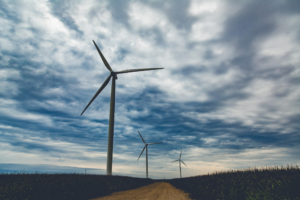Source: Tony Webster/Creative Commons
The Minnesota Environmental Partnership is proud to feature the following post as part of our Student Voices Series. This is part of a continuing collaboration with Macalester College’s Geography Department and its students. The following column was contributed by Katie Lund and represents her views.
As countries around the world commit themselves to a clean energy future, the Trump Administration is clinging on to the fossil fuel industry. The time has come for states to lead the clean energy transition. If we have the political will, Minnesota can be a leader in this transition.
Throughout this past year, the Trump administration has used the slogan of “energy dominance” to describe its energy policy. Central to this policy is keeping the United States reliant on fossil fuel sources of energy such as coal, oil and gas. In just the past year, this policy has led to the support of the construction of the Keystone XL and Dakota Access pipelines, and the proposal to open up U.S. waters to offshore drilling – including in the Arctic National Wildlife Refuge.
In his first State of the Union Address on January 30th, President Trump even boasted about his administration’s efforts to promote fossil fuels.
“We have ended the war on American energy – and we have ended the war on beautiful, clean coal,” he said.
By continuing to promote the use and development of fossil fuel resources, the United States is losing the clean energy leadership it once had on the federal level.
Last November I attended the UN Climate Summit (COP23) in Bonn, Germany, an international gathering of countries to assess progress in dealing with climate change, as a student observer. While the United States took a leadership role at these conferences under the Obama administration, the American presence at this conference was a shadow of its former self. The Trump administration sent a very small delegation, remained largely silent during negotiations, and decided to use their only scheduled event to promote the continued use of coal – a decision that was ridiculed on the international stage and subjected to protest.
Just three days after the Trump administration put on the fossil fuel promoting event, a global alliance was formed between countries including the United Kingdom and Canada to declare a phase out of coal. It was a rebuke to Donald Trump’s policies. The message couldn’t have been clearer – the rest of the world was ready to move on, leaving the United States behind.
It appears unlikely that the Trump administration will embrace a clean energy transition. That’s why we now have to focus on efforts on local action. If the Trump administration won’t fight for the clean energy future we want, states, local governments, and communities must take up the fight.
Numerous states, cities, and local communities across the country have committed themselves to pursuing a clean energy agenda. Over 50 U.S. cities including Portland, St. Louis, and Salt Lake City have made commitments to transition to 100% renewable energy. Currently 15 states, including Minnesota, have joined the United States Climate Alliance, a bipartisan coalition of states committed to upholding the Paris Agreement by reducing greenhouse gas emissions. All across the country, local leaders are stepping up.
Minnesota has emerged as a leader in this movement. The state passed historic clean energy laws in 2007 and 2013, which encouraged renewable energy development across the state. Clean energy jobs contribute greatly to the state’s economy. Xcel Energy, a major electric utility, has already cut carbon emissions 23 percent below 2005 levels and plans to add huge amounts of wind and solar developments. Renewable energy now makes up 25% of Minnesota’s electricity generation, putting it in second place as Minnesota’s largest source of electricity generation. This track record is impressive, but we must not become complacent.
I urge the Minnesota Legislature to use this legislative session to take clean energy policy in Minnesota to the next step. On February 22nd, a new bill was introduced in the Minnesota House (HF 3003), which allows for large hydroelectric and nuclear energy to count toward the Renewable Energy Standard and changes the name to the Carbon Free Standard, but it does not change the percentage of said energy that utilities are required to meet. This bill will not take the crucial next step that Minnesota needs in order to continue to be a leader in the clean energy transition. The Minnesota legislature must take advantage of the momentous growth of renewable energy and set an ambitious goal to increase the Renewable Energy Standard to 50% by 2030 as former Lieutenant Governor Tina Smith proposed last year.
If Minnesota is to remain a clean energy and climate leader, we must push our local leaders. Cities around Minnesota – join peers such as the city of Rochester and commit yourselves to the transition to 100% renewable energy. No matter who you are, let your voice be heard. A clean energy future is in sight and our peers around the world are committing themselves to it. If the Trump administration insists on holding the United States back on the world stage, we, as Minnesotans, can join the world in imagining and pursuing a future free of fossil fuels.
